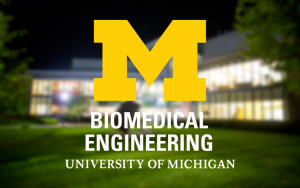Presented By: Biomedical Engineering
BME 500 Seminar: A machine learning-based predictive model of genome-wide binding of the Aryl Hydrocarbon Receptor
Sudin Bhattacharya, Ph.D. Assistant Professor of Biomedical Engineering, Michigan State University

Abstract:
The Aryl Hydrocarbon Receptor (AhR) is an inducible transcription factor (TF) whose ligands include the potent environmental contaminant 2,3,7,8-tetrachlorodibenzo-p-dioxin (TCDD). TCDD-mediated toxicity is believed to occur through activation of AhR and its binding to the 5'-GCGTG-3' DNA motif, referred to as the Dioxin Response Element (DRE). However, AhR binding in intact human cells is highly dynamic and tissue-specific. Approximately 50% of all experimentally verified AhR binding sites do not contain a DRE, and a great number of otherwise accessible DREs are not bound by AhR. Identification of the determinants of tissue-specific AhR binding is crucial for understanding downstream gene regulatory effects and potential adverse health outcomes of TCDD exposure, such as liver toxicity and immune suppression. We applied XGBoost, a supervised machine learning architecture, to predict genome-wide AhR binding as a function of DNA sequences immediately flanking the DRE, and local chromatin context features such as DNase-seq, histone modifications, and TF ChIP-Seq signals, as well as DRE proximity to gene promoters. We predicted binding of induced AhR in MCF-7 breast cancer cells, human hepatocytes, and the human lymphoblastoid cell line GM17212, as well as constitutive AhR binding in HepG2 cells. Our results demonstrate highly accurate and robust models of within-tissue binding, with several specific TFs and HMs identified as predictive of AhR binding within and across tissues. Additionally, we show that tissue-specific AhR binding is driven by a complex interplay of DNA flanking sequence and local chromatin context.
The Aryl Hydrocarbon Receptor (AhR) is an inducible transcription factor (TF) whose ligands include the potent environmental contaminant 2,3,7,8-tetrachlorodibenzo-p-dioxin (TCDD). TCDD-mediated toxicity is believed to occur through activation of AhR and its binding to the 5'-GCGTG-3' DNA motif, referred to as the Dioxin Response Element (DRE). However, AhR binding in intact human cells is highly dynamic and tissue-specific. Approximately 50% of all experimentally verified AhR binding sites do not contain a DRE, and a great number of otherwise accessible DREs are not bound by AhR. Identification of the determinants of tissue-specific AhR binding is crucial for understanding downstream gene regulatory effects and potential adverse health outcomes of TCDD exposure, such as liver toxicity and immune suppression. We applied XGBoost, a supervised machine learning architecture, to predict genome-wide AhR binding as a function of DNA sequences immediately flanking the DRE, and local chromatin context features such as DNase-seq, histone modifications, and TF ChIP-Seq signals, as well as DRE proximity to gene promoters. We predicted binding of induced AhR in MCF-7 breast cancer cells, human hepatocytes, and the human lymphoblastoid cell line GM17212, as well as constitutive AhR binding in HepG2 cells. Our results demonstrate highly accurate and robust models of within-tissue binding, with several specific TFs and HMs identified as predictive of AhR binding within and across tissues. Additionally, we show that tissue-specific AhR binding is driven by a complex interplay of DNA flanking sequence and local chromatin context.